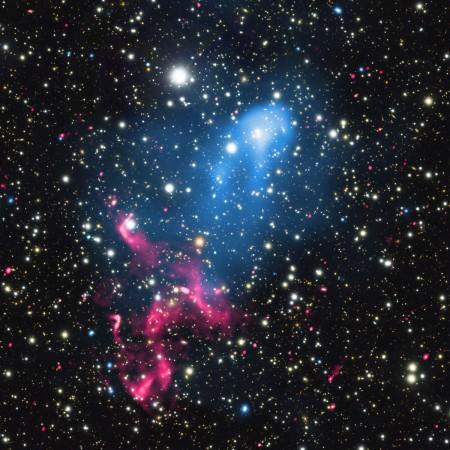
Astronomers have observed a unique phenomenon unlike anything ever seen before, after two enormous colliding galaxies met with a supermassive black hole to create a stunning cosmic particle accelerator.
Also Read: SpaceX gets set to launch world's most powerful rocket, the Falcon Heavy
This discovery was made by researchers after trawling through data collected by NASA's Chandra X-ray Observatory, which comprises the Giant Metrewave Radio Telescope (GMRT) in India, the NSF's Karl G. Jansky Very Large Array, and various other telescopes.
The data led scientists to discover what actually happens when matter emitted by a supermassive black hole hits two unifying galaxies.
"We have seen each of these spectacular phenomena separately in many places," said Reinout van Weeren of the Harvard-Smithsonian Center for Astrophysics (CfA) in Cambridge, Massachusetts, who was the lead author of this study.
"This is the first time, however, that we have seen them linked together in the same system," he added.
The two colliding galaxies are referred to as a "double whammy". Located two billion light years from Earth, they are dubbed Abell 3411 and Abell 3412. These galaxy clusters are so large that they weigh around a million billion times the Sun's mass
A supermasive black hole in one of the superclusters creates a spinning magnetic funnel that hurls some of the inflowing gas outwards. When this gas, which often travels at relativistic speeds, encounters "cosmic booms" created by collisions of gas clouds in the clusters, they are accelerated further. This leads to the comet-shaped X-Ray view seen by Chandra.
"It's almost like launching a rocket into low-Earth orbit and then it being shot out of the Solar System by a second rocket blast," co-author Felipe Andrade-Santos, also of the CfA, told NASA.
"These particles are among the most energetic particles observed in the universe, thanks to the double injection of energy," Andrade-Santos added.
This findings helped solve the mystery regarding the origin of the spinning swirls of radio emissions spanning millions of light years across, which were observed in galaxy clusters Abell 3411 and Abell 3412, with the help of the GMRT.
It was found that these swirls were created by double-accelerated particles as the shock waves travelled across clusters for hundreds of millions of years.
"This result shows that a remarkable combination of powerful events generate these particle acceleration factories, which are the largest and most powerful in the universe," said co-author William Dawson of Lawrence Livermore National Lab in Livermore, California.
"It is a bit poetic that it took a combination of the world's biggest observatories to understand this," Dawson said further.
The above revelations were made at the 229th meeting of the American Astronomical Society meeting in Grapevine, TX.
This study appears in the journal Nature Astronomy as well.














